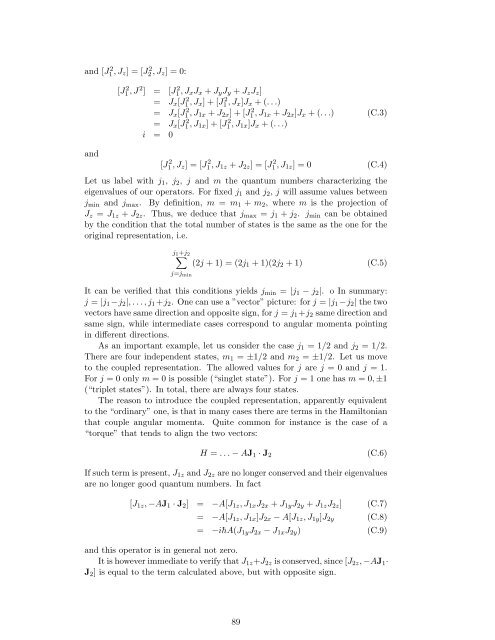Numerical Methods in Quantum Mechanics - Dipartimento di Fisica
Numerical Methods in Quantum Mechanics - Dipartimento di Fisica
Numerical Methods in Quantum Mechanics - Dipartimento di Fisica
You also want an ePaper? Increase the reach of your titles
YUMPU automatically turns print PDFs into web optimized ePapers that Google loves.
and [J 2 1 , J z] = [J 2 2 , J z] = 0:<br />
[J1 2, J 2 ] = [J1 2, J xJ x + J y J y + J z J z ]<br />
= J x [J1 2, J x] + [J1 2, J x]J x + (. . .)<br />
= J x [J1 2, J 1x + J 2x ] + [J1 2, J 1x + J 2x ]J x + (. . .)<br />
= J x [J1 2, J 1x] + [J1 2, J 1x]J x + (. . .)<br />
i = 0<br />
(C.3)<br />
and<br />
[J 2 1 , J z ] = [J 2 1 , J 1z + J 2z ] = [J 2 1 , J 1z ] = 0 (C.4)<br />
Let us label with j 1 , j 2 , j and m the quantum numbers characteriz<strong>in</strong>g the<br />
eigenvalues of our operators. For fixed j 1 and j 2 , j will assume values between<br />
j m<strong>in</strong> and j max . By def<strong>in</strong>ition, m = m 1 + m 2 , where m is the projection of<br />
J z = J 1z + J 2z . Thus, we deduce that j max = j 1 + j 2 . j m<strong>in</strong> can be obta<strong>in</strong>ed<br />
by the con<strong>di</strong>tion that the total number of states is the same as the one for the<br />
orig<strong>in</strong>al representation, i.e.<br />
j 1<br />
∑+j 2<br />
j=j m<strong>in</strong><br />
(2j + 1) = (2j 1 + 1)(2j 2 + 1)<br />
(C.5)<br />
It can be verified that this con<strong>di</strong>tions yields j m<strong>in</strong> = |j 1 − j 2 |. o In summary:<br />
j = |j 1 −j 2 |, . . . , j 1 +j 2 . One can use a ”vector” picture: for j = |j 1 −j 2 | the two<br />
vectors have same <strong>di</strong>rection and opposite sign, for j = j 1 +j 2 same <strong>di</strong>rection and<br />
same sign, while <strong>in</strong>terme<strong>di</strong>ate cases correspond to angular momenta po<strong>in</strong>t<strong>in</strong>g<br />
<strong>in</strong> <strong>di</strong>fferent <strong>di</strong>rections.<br />
As an important example, let us consider the case j 1 = 1/2 and j 2 = 1/2.<br />
There are four <strong>in</strong>dependent states, m 1 = ±1/2 and m 2 = ±1/2. Let us move<br />
to the coupled representation. The allowed values for j are j = 0 and j = 1.<br />
For j = 0 only m = 0 is possible (“s<strong>in</strong>glet state”). For j = 1 one has m = 0, ±1<br />
(“triplet states”). In total, there are always four states.<br />
The reason to <strong>in</strong>troduce the coupled representation, apparently equivalent<br />
to the “ord<strong>in</strong>ary” one, is that <strong>in</strong> many cases there are terms <strong>in</strong> the Hamiltonian<br />
that couple angular momenta. Quite common for <strong>in</strong>stance is the case of a<br />
“torque” that tends to align the two vectors:<br />
H = . . . − AJ 1 · J 2<br />
(C.6)<br />
If such term is present, J 1z and J 2z are no longer conserved and their eigenvalues<br />
are no longer good quantum numbers. In fact<br />
[J 1z , −AJ 1 · J 2 ] = −A[J 1z , J 1x J 2x + J 1y J 2y + J 1z J 2z ] (C.7)<br />
= −A[J 1z , J 1x ]J 2x − A[J 1z , J 1y ]J 2y (C.8)<br />
= −i¯hA(J 1y J 2x − J 1x J 2y ) (C.9)<br />
and this operator is <strong>in</strong> general not zero.<br />
It is however imme<strong>di</strong>ate to verify that J 1z +J 2z is conserved, s<strong>in</strong>ce [J 2z , −AJ 1·<br />
J 2 ] is equal to the term calculated above, but with opposite sign.<br />
89
















